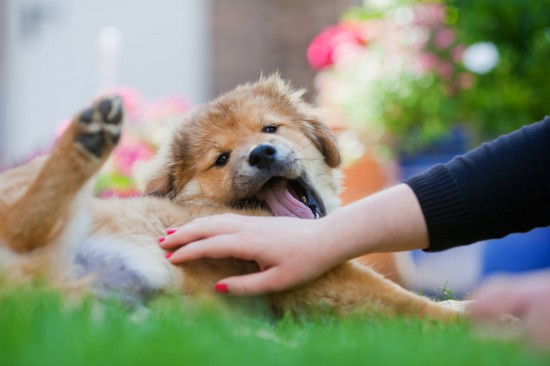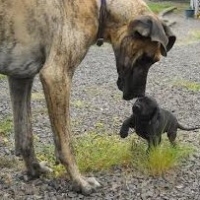
There are many reasons why a dog will strain at the leash. These vary from aggression towards other dogs and/or people, to fear of the surroundings or conditions. Probably the most common reason for this very annoying and potentially dangerous behaviour is excitement coupled with a lack of discipline and dominance on the part of the owner/handler.
There are 6 basic needs that a dog has to have in order to survive. These are Food, Water, Exercise, A Pack, Leadership and Love and Affection. Without any of these 6 needs the dog will not survive for very long. The needs that concern us with the problem in hand are; A Pack, Leadership and Love and Affection. Why are these factors so important I hear you ask? Let’s look at them individually.
The Pack.
Dogs are pack animals. In the wild, like wolves there is a strict hierarchy amongst the members of the group. The pack is normally led by the Alpha Female. She has risen to this position by a mixture of dominance, cunning and her ability to read and sum up situations quickly and accurately. The Alpha Male is next in line. He is the only dog that will mate with the Alpha Female. He has fought all comers to attain this position. He normally deals with the defence of the group. It is his job to challenge and fight other animals that want to take over the pack. All the other members of the pack will determine their own place within it by fighting, guile and alliances with more dominant animals. A few will, on maturing, try to rise to Alpha Male.
So it is vital that your dog knows his position in the pack. In this instance your family is his pack. You must be pack leader and the other family members must always remain dominant to the dog. At no time from a puppy onwards must the dog be allowed to show signs of aggression to any family member. Punishment for this offence should be swift and uncompromising.
Leadership.
If you were going by car from your house to say the next town and you had no map, were new to the area and alone, added to that being blind as well, you would, I am sure, agree that the chances of getting to your destination would be pretty slim.
Equally your dog, in the wild, would find himself in a similar position. If the pack had no leader there would be no focus to the activities. So without the pack hierarchy there would be no direction for the pack and a consequent disbanding would soon occur.
Because dogs hunt as a pack this would end with the death of the individual members from either starvation or predation by other species. The lower orders within the pack never challenge the decisions of the pack leaders. Failure to behave as part of the pack will often result in expulsion.
Love and Affection.
You have hopefully noted that if you praise your dog when he does something good he will wag his tail and sometimes if you scold him he will roll over on to his back showing his belly and often leak urine.
The first reaction is the dog’s natural response to love and affection. He will react in this way when greeting other pack members. He will show excitement and will rush about, sometimes barking and whining or giving little yips of pleasure as well as showing submission to higher pack members.
The second response will often be shown to the pack leaders and signifies his submissiveness to them. By exposing his belly he is in effect offering them his life because he would be unable to defend himself from attack in this position. Urination in this position emphasises his actions.
The dog will naturally follow these instinctive behaviour patterns, so by using a mixture of strong commands and lavish praise he can be taught to do most things. The important things to remember are to be consistent, use the same command each time, to be persistent, don’t give in and to always end your training session on a success.
This last point means that no matter how long it takes you must get the response you require even if it is only briefly. As soon as you get that response praise the dog and then stop the session.
Your commands should be easy to understand, one word instructions that cannot be confused with each other. They should be delivered in a firm, no nonsense voice. The commands I use are; Heel, Sit, Down, Stand, Close, Come and Stay. Each of these commands is reinforced with an appropriate hand signal. For example Sit is signalled with the right elbow bent, hand facing palm forward at shoulder height, while Down is a downward sweep of the straight arm from horizontal to about 45 degrees.
So to cure the problem of the dog pulling, hold the leash in your right hand, keeping the left arm bent across your body and give the command “Heel” whilst moving off. As soon as the dog’s head starts to move forward of your bodyline give the command “Heel” and at the same time smartly tug the leash to your right, returning it to its original position immediately. This will pull the dog off balance and make it transfer its attention to you. Your left hand should only be used when turning left in order to stop the dog crossing your body and causing you to trip. This is done by simply dropping the arm down to the left thigh so that it traps the leash between hand and leg.
Remember it is the tone of your voice that is important. It should be a command not a request, so deliver it in a crisp manner, lowering the tone at the end of the word, rather than raising it and ending up pleading. No matter what happens do not lose your temper with the dog. Do not raise your voice and shout at him, it will only hurt his ears, or frighten him. When he is walking to heel, praise him for doing well. Use a calm, well done, sort of tone and give him a quick pat.
Small dog treats or tiny squares of cheese used as bribes work wonders. Keep a piece in your left hand, where the dog can smell it. When you want to gain his attention, just lower the hand towards his face. This is easier with a big dog, but can still be done effectively even with a miniature breed.
Rickie Haughton is a Kennel Club of Great Britain Good Citizen Dog Scheme registered trainer and has bred, shown and trained dogs for over 35 years. His expertise covers all aspects of breeding, rearing, showing, training and behaviour in breeds of all sizes. Together with his wife, Lesley, they own the Bassmas Basset Hound and English Mastiff Kennels in Somerset, England. Occasionally they have puppies for sale to approved homes only. They can be contacted at [email protected] This article can also be seen at http://www.poodle-lovers.com
 Leonberger Dog Health And Longevity
Leonberger Dog He
Leonberger Dog Health And Longevity
Leonberger Dog He
 Whom to visit for the ventilated Chicken Runs in the market?
Whom to visit for the ventilated Chicken Runs in the marke
Whom to visit for the ventilated Chicken Runs in the market?
Whom to visit for the ventilated Chicken Runs in the marke
 The Importance Of Companionship And Quality Time For Dogs
The Importance Of
The Importance Of Companionship And Quality Time For Dogs
The Importance Of
 Best Puppy Food Large Breed Review
What is a large breed puppy? A large breed puppy will gr
Best Puppy Food Large Breed Review
What is a large breed puppy? A large breed puppy will gr
 Nova Scotia Duck Tolling Retriever Hereditary Health And Health Testing
Nova Scotia Duck
Nova Scotia Duck Tolling Retriever Hereditary Health And Health Testing
Nova Scotia Duck
Copyright © 2005-2016 Pet Information All Rights Reserved
Contact us: www162date@outlook.com